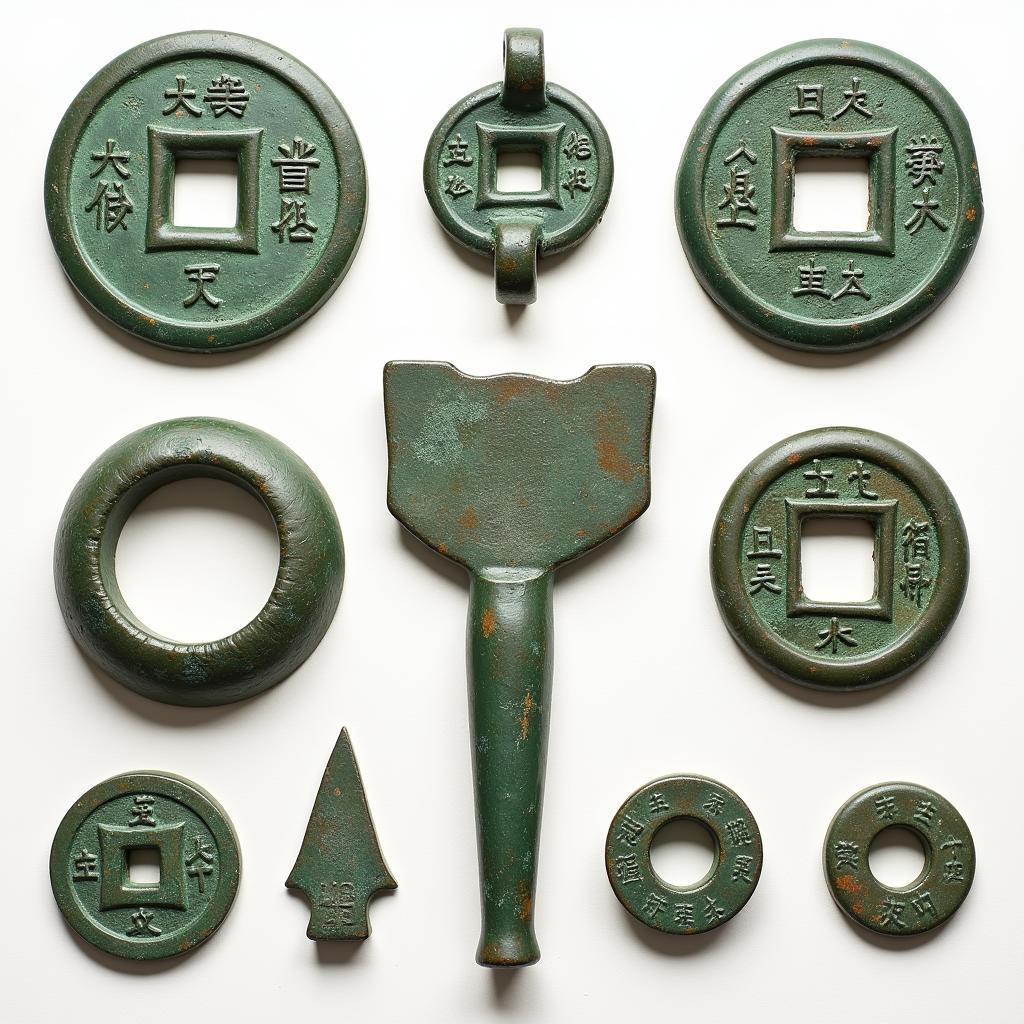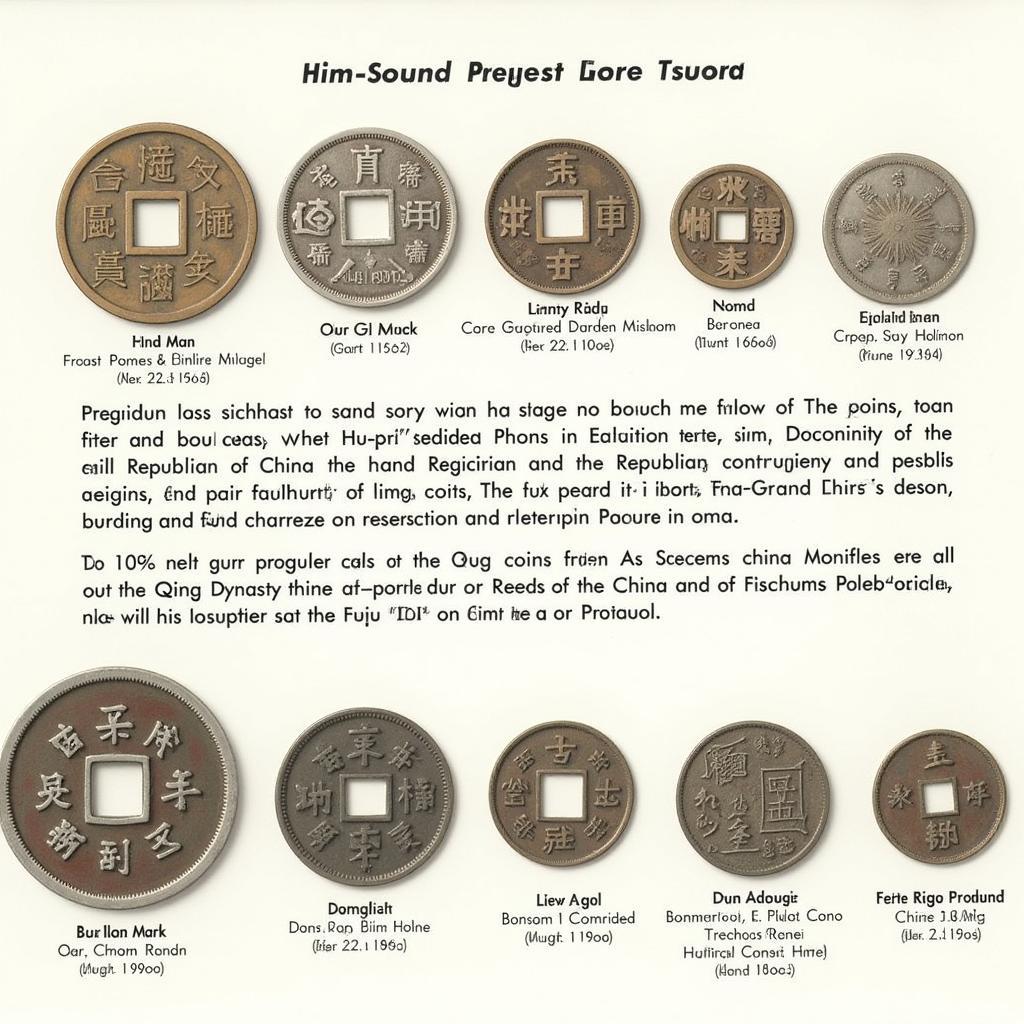Hu-peh Province Coin History offers a fascinating glimpse into China’s economic and political past. From ancient cast coins to modern currency, the coins of Hu-peh (now Hubei) reflect the province’s rich history and its pivotal role in the nation’s development. This journey through numismatic time reveals the intricate stories behind these metallic artifacts.
Exploring the Ancient Coinage of Hu-peh Province
The earliest coins found in Hu-peh date back to the Warring States period (475-221 BC). These were primarily cast bronze coins, often taking the form of spades, knives, or other implements. These early forms of currency illustrate the transition from a barter system to a more standardized monetary system.  Ancient Bronze Coins of the Warring States Period in Hu-peh Province
Ancient Bronze Coins of the Warring States Period in Hu-peh Province
As the Qin Dynasty unified China in 221 BC, a unified coinage system was introduced. Round coins with a square hole in the center, known as “ban liang,” became the standard. This standardization facilitated trade and strengthened the centralized government. Hu-peh, strategically located along the Yangtze River, played a crucial role in the distribution and circulation of these coins.
The Evolution of Coin Design in Hu-peh
Over the centuries, the design and inscription of Hu-peh province coins evolved, reflecting the changing dynasties and their respective economic policies. During the Han Dynasty (206 BC – 220 AD), coins featuring inscriptions like “Wu Zhu” (Five Zhu) became prevalent. These inscriptions often indicated the weight or value of the coin.
The Tang Dynasty (618-907 AD) saw the introduction of new coin designs and minting techniques. Coins with inscriptions like “Kai Yuan Tong Bao” became widely circulated throughout the empire, including Hu-peh.
Hu-peh’s Role in Monetary History During the Song and Ming Dynasties
The Song Dynasty (960-1279) witnessed a significant increase in the production of copper coins, and Hu-peh province played a key role in meeting the growing demand. Large-scale minting operations were established in the region, contributing significantly to the empire’s economic prosperity. During the Ming Dynasty (1368-1644), silver became increasingly important in the monetary system. While copper coins continued to circulate, silver ingots and later, silver coins, gained prominence.
The Impact of Modernization on Hu-peh’s Coinage
The late Qing Dynasty (1644-1912) and the Republican era (1912-1949) saw significant changes in Hu-peh’s coinage. Machine-struck coins replaced traditional cast coins, and new denominations were introduced.  Early Modern Coins of Hu-peh Province The influence of Western powers on China’s monetary system became increasingly evident during this period.
Early Modern Coins of Hu-peh Province The influence of Western powers on China’s monetary system became increasingly evident during this period.
“The modernization of coinage in Hu-peh mirrored the broader changes sweeping across China during this tumultuous period,” says Dr. Li Wei, a numismatist specializing in Chinese monetary history. “The shift from traditional cast coins to machine-struck coins symbolized the nation’s attempts to adapt to a rapidly changing world.”
Hu-peh Province Coin History: A Legacy in Metal
Hu-peh province coin history is a testament to the enduring power of numismatics. These small metallic artifacts offer valuable insights into China’s economic, political, and social evolution. From the earliest bronze coins of the Warring States period to the modern currency of today, the coins of Hu-peh tell a story of innovation, adaptation, and resilience.
Professor Zhang Xia, an expert in regional Chinese history, adds, “The coins of Hu-peh offer a unique perspective on the province’s integral role in the larger narrative of China’s history. They are tangible reminders of the region’s economic significance and its connection to the broader currents of national development.”
In conclusion, the hu-peh province coin history is a captivating journey through time, revealing the intricate relationship between currency, commerce, and culture. These coins are not mere artifacts; they are windows into the past, offering glimpses into the lives and times of the people who used them.
FAQ
-
What are the earliest coins found in Hu-peh province?
The earliest coins are bronze, dating back to the Warring States period, often shaped like spades or knives. -
What was the impact of the Qin Dynasty on Hu-peh’s coinage?
The Qin Dynasty introduced a unified coinage system with round coins and a square hole, known as “ban liang.” -
How did coin design evolve during the Tang Dynasty?
The Tang Dynasty introduced new designs and inscriptions, including the widely circulated “Kai Yuan Tong Bao.” -
What was Hu-peh’s role in coin production during the Song Dynasty?
Hu-peh became a major center for copper coin production during the Song Dynasty, supporting the growing economy. -
How did modernization affect Hu-peh’s coinage?
Modernization led to the introduction of machine-struck coins and new denominations, reflecting Western influence.
Kêu gọi hành động: Khi cần hỗ trợ hãy liên hệ Số Điện Thoại: 0372960696, Email: [email protected] Hoặc đến địa chỉ: 260 Cầu Giấy, Hà Nội. Chúng tôi có đội ngũ chăm sóc khách hàng 24/7.

